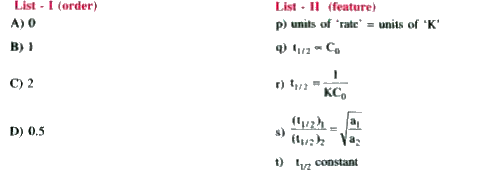In hypothetical reversible reaction
A(1M)t1/2=6.93min⇐========⇒t1/2=2minB(0.4M)
Forward reaction =1st order
Backward reaction =0 order
What is the rate of disappearance of A at the given moment?Solution in Telugu
The correct Answer is:0
(t12)=6.93 min (1st order A⇔B(t11)0=2 min (zero order)
r=−d[A]dt=[(0.1)×(1)1−(0.1)(0.4)∘],r=(0.1−0.1)=0⇒r=0
Topper's Solved these Questions
- BOOK - AAKASH SERIESCHAPTER - CHEMICAL KINETICSEXERCISE - PRACTICE SHEET-1 (SINGLE OR MORE THAN ONE OPTION QUESTIONS)16videos
CHEMICAL KINETICS
- BOOK - AAKASH SERIESCHAPTER - CHEMICAL KINETICSEXERCISE - PRACTICE SHEET-1 (LINKED COMPREHENSION TYPE QUESTIONS)6videos
CHEMICAL KINETICS
- BOOK - AAKASH SERIESCHAPTER - CHEMICAL KINETICSEXERCISE - LEVEL-II(LECTURE SHEET EXERCISE-III MATCH THE FOLLOWING QUESTIONS)3videos
CHEMICAL KINETICS
- BOOK - AAKASH SERIESCHAPTER - CHEMICAL KINETCSEXERCISE - EXERCISE - 3.245videos
CHEMICAL KINETCS
- BOOK - AAKASH SERIESCHAPTER - CHEMICAL THERMODYNAMICSEXERCISE - Additional Practice Exercise54videos
CHEMICAL THERMODYNAMICS
Similar Questions
For the reaction N2+3H2→2NH3 , the rate d[NH3]dt=2×10−4Ms−1. Therfore the rate −d[N2]dt is given
01:51View SolutionThe instantaneous rate of an elementary chamical reactkon aA+bB⇔cC+dD can be given by rate =Kf[A]a[B]b−Kb[C]c[D]d where Kf and Kb are rate constants for forward and backward reactions respectively for the reversible reaction. If the reaction is an irreversible one, the rate is expressed as, rate =K[A]a[B]b where K is rate contant for the given irreversible rate of disappearance of A is a/b times the rate of disappearance of B. The variation of rate constant K with temperature is expressed in terms of Arrhenius equation: K=Ae−Ea/RT whereas the ratio KfKb is expressed in terms of van't Hoff isochore: KfKb=Ae−ΔH/RT, where Ea and ΔH are energy of activation and heat of reaction respectively.
The variation of rate constant K and KfKb with temperature shows the following effects:
For endothrmic reaction when T increases then K increases and KfKb also increases.
(ii) For endothemic reaction when T decreases then K decreases and KfKb also decreases.
(iii) For exothermic when T increases then K and KfKb both increases.
(iv) For exothermic reaction when T decreases then K increases and KfKb decrease.
(v) For exothermic reaction when T increases thenK and KfKb both decrease.01:02View SolutionMatch the following columns
 00:52View Solution
00:52View SolutionDiscuss on the kinetic spontaneity of a chemical reaction. Is a slow reaction spontaneous? Why?
00:42View SolutionWhich among the following is not an exact differential?
02:11View Solution2SO2+O2k1⇐⇒k22SO3
What are the expresison for the rate law of the forward and backward reactions?02:41View SolutionFor a first order reaction, t_(1//2) = underset(k)ul(...........) .
02:08View SolutionA first order reaction has t_(1//2) = 6.93 min . The rate constant is……….. .
06:40View SolutionThe acid catalysed ionisation of gamma -hydroxy butyric acid proceeds as a reversible reaction. Which is I order in both the forward and backward steps: underset("(Acid)")(A) underset(K_(1)) overset(K_(2))(hArr) underset("(Lactose)")(B) The rate -(d[A])/(d t) is given by:
04:12View SolutionT50 of first order reaction is 10 min. starting with 10 mol−1 rate after 20 min is :
02:11View SolutionIF the t_(1//2) for a first order reaction 0.4 min, the time of or 99.9% completion of the reaction is ............min.
View SolutionThe rate constant of a reaction is 3xx10^(2)" min"^(-1) . What is the order of reaction ?
02:05View SolutionFollowing data is obtained in a chemical reaction occuring with a single reactant. The order of the reaction will be (if t1/2=40min,t3/4=360min) :
02:37View SolutionThe rate constant and half-life of a first order reaction at temperature T1 are k1min−1andx1min , respectively and those at temperature T2 are k2min−1andx2 min , respectively. If T2>T1 , which is greater , x1 or, x2 ?
03:31View SolutionWhat fraction of a reactant remains unreacted after 40 min if t1/2 is of the reaction is 20 min? consider the reaction is first order
02:50View Solution

